 Image: Pixabay
Image: PixabayEmail marketing is an effective communication tool of the company with the audience, which has proved its effectiveness. However, in order for it to work truly effectively, it is necessary to monitor current trends and analyze them.
In recent years, serious changes have taken place in the way subscribers follow and respond to emails. We collected statistics for six years and based on it we identified the main trends - this will help to understand current trends and avoid mistakes in the preparation of newsletters.
Trend # 1. People are less active in opening letters.
In general, everything is logical here. Over the course of six years, the number of letters sent and received by email users every day has been steadily increasing. There are
statistics according to which, from only 2015 to the current year, email traffic grew by 41 billion a day!
Now inboxes of any user are much more actively clogged with letters, so it is simply impossible to open them all physically. So the rate of openness of email messages is reduced.
According to DashaMail statistics, the average open rate when working with databases of up to 5000 addresses is now 15.24%, in 2013 it was 23.56%. When working with databases from 5,000 addresses and up to 100,000 addresses, now - 9.34%, in 2013 - 11.4%.
What to do? When working with larger databases (from 5000 subscribers), pay special attention to segmentation and send content that meets the interests and needs of subscribers. Use multivariate and
Gestalt testing tools to increase the open rate of each newsletter.
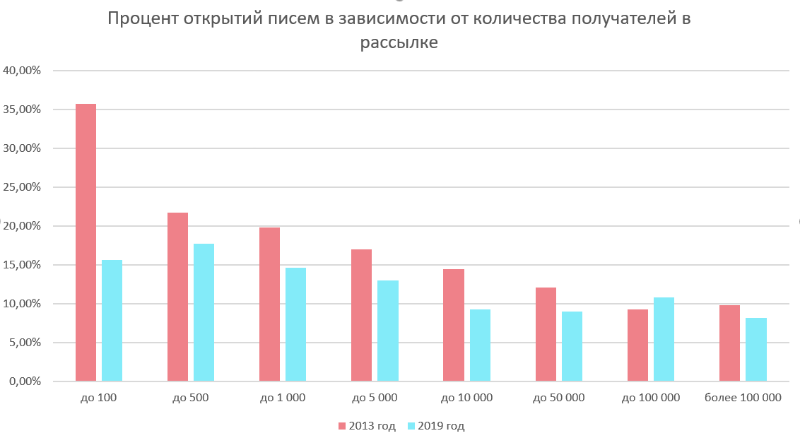
Trend # 2. Newsletter lifespan reduced
Six years ago, the reaction of subscribers was quite “blurred” in time. For example, half of the opening of letters took place during the first eight hours after sending:
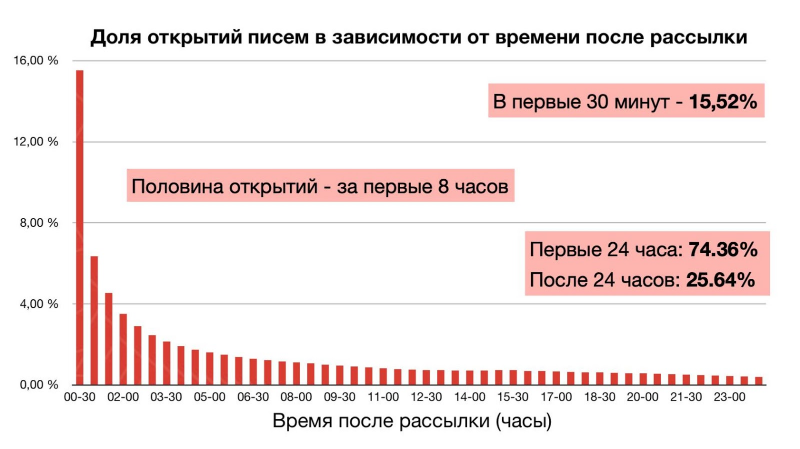
Now, the reaction rate of subscribers has increased radically: half of the discoveries occur in the first 3.5 hours.
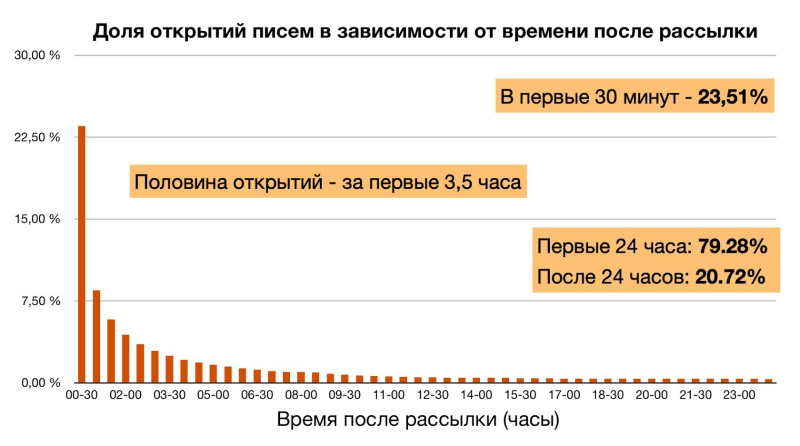
There are more letters, with the development of mobile Internet and the spread of various gadgets, checking mail has become easier. Therefore, the speed of delivering information in the newsletter today has significantly increased compared to 2013.
At the moment, if your message has not been opened within a couple of hours after sending it, the probability of opening it in the future is dramatically reduced. That is why companies are trying their best to attract the attention of their subscribers, for example, trying different options for themes, as well as emoji and
even unicode .
Trend # 3. Now mailings are more often open before noon
In 2013, we observed a smooth distribution of discoveries throughout the day. Letters were rather actively viewed from 9:00 to 16:00, that is, the newsletter lived during the working day.
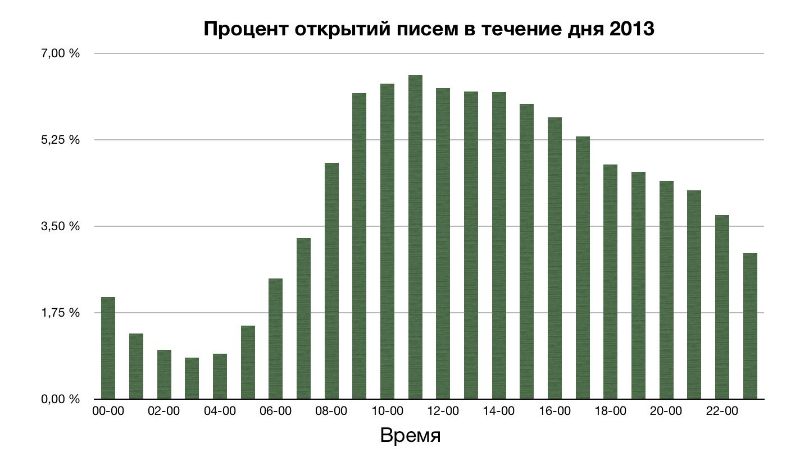
Now the picture has changed: at present, the peak time of discoveries falls on the interval from 9:00 to 12:00, and then there is a sharp decline.

At the same time, a surge in activity begins as early as 8:00 - the average open rate at this time is 6.3%, which is pretty good. This is because people check mail from mobile devices on the way to work. Six years ago, morning activity was lower - the open rate did not exceed 4.7%. To maximize the conversion of the morning audience viewing mail from mobile devices, letters should be adaptive. Any newsletter must be sent via a test list of addresses and check the display on mobile gadgets.
In order to “hook” the audience that did not open the letter within the first few hours, you can use the “send” function in DashaMail. This tool allows you to resend a newsletter - with a changed topic - to those subscribers who have not opened its main version. About how this works in practice, we described in
this article .
Trend # 4. Mail.Ru mail is losing ground on the Russian Internet
Compared to 2013, the proportion of mailboxes on Mail.ru decreased markedly - from 68.3% to 53.85%. That is, in six years, the largest Russian email provider has lost almost 15%. At the same time, the share of Yandex.Mail and Gmail significantly increased:
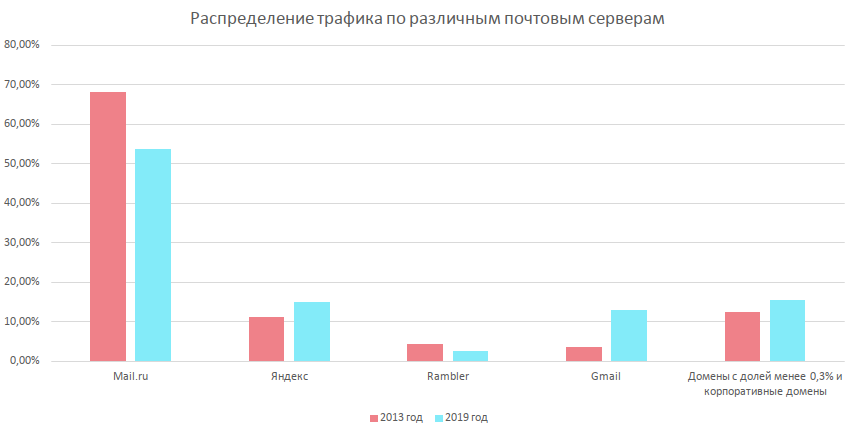
For companies, this means that it is necessary to work to ensure that letters are correctly displayed in different email clients. Indeed, even if you have an exclusively Russian audience, the proportion of Gmail mailboxes in the database will still be constantly increasing.
Conclusion
In conclusion, we will once again go over the main changes that have occurred over six years.
- Letters open less actively . The number of email messages is growing rapidly, people are getting less and less time, so the rate of discoveries is decreasing.
- Newsletters now live less . If several years ago the newsletter was actively opened within a few days after sending, now the rule is simple: it was not possible to attract attention in the first few hours, which means that the letter is unlikely to show a good result.
- Users actively check mail in the morning . This is partly facilitated by the spread of mobile devices - now it is convenient to check mail on the way to work. And if earlier mailings were actively opened all day, now the peak falls on time before lunch.
- Mail.Ru is losing ground . The mail service has lost 15% of the market share, but email products from Yandex and Google, on the contrary, have grown.
The first two trends seem pessimistic. And the question arises: why invest, if there is a clear tendency to decrease interest in newsletters? Email marketing is turning into a tool that you need to use competently and skillfully. Despite the low entry threshold, it requires not only certain skills, but also creativity, desire and the ability to experiment. Newsletters begin to work when the marketer or email marketer thoughtfully uses this channel, and does not randomly “jump” from the newsletter to the newsletter without a general concept.
To keep abreast of current trends in email marketing in Russia, to receive useful life hacks and our materials - subscribe to the DashaMail Facebook page and read our blog.
To keep abreast of current trends in email marketing in Russia, to receive useful life hacks and our materials - subscribe to the DashaMail Facebook page and read our blog .